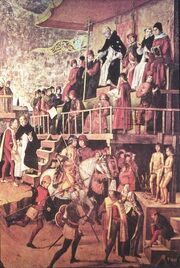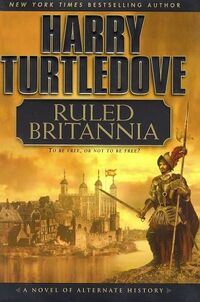
An auto de fé was the ritual of public penance of condemned heretics and apostates that took place when the Spanish Inquisition or the Portuguese Inquisition had decided their punishment. Auto de fé in medieval Spanish and Portuguese) means "act of faith". The phrase is used most frequently in English in its alternative Portuguese form auto-da-fé.
In the popular imagination, "auto-da-fé" has come to refer to burning at the stake for heresy.
Auto de fe in Ruled Britannia
The English Inquisition made frequent use of the Auto da fe in the execution of heretics against the Catholic Church practiced in England during the reign of Queen Isabella from 1588 to 1598.
In England, an auto da fe was a lavish and gawdy affair put on public display and often overseen by Isabella herself. It would be preceded by a spectacular parade involving hundreds of people. In the rear would be prisoners of the English Inquisition who had refused to recant whatever heretical belief they had been accused of on multiple occasions. The majority of those executed were Protestants but also included alchemists, homosexuals, and other heretics.
After reaching the site of the auto da fe, the accused were tied to stakes, and bonfires were built around the stakes, and the heretics were immolated. The method of execution was designed to mimic the fires of Hell to which it was believed the executed would be consigned upon their deaths.
On November 1, 1597 William Shakespeare witnessed an auto da fe in London. This led to his initial disaffection from the Spanish-backed Catholic government in England, ultimately leaving him receptive to playing a part in the anti-Spanish uprising orchestrated by William and Robert Cecil by writing the English nationalistic play Boudicca.
Under the Protestant Queen Elizabeth, executions of Catholics, Puritans, and others accused of heresy against the Church of England or some other form of subversion were only slightly less painful and slightly less showy. The heretic would first be hanged with a four-knotted noose too light to break his neck and left to strangle. He would then be taken down before he died and would be drawn and quartered. Decapitation would follow, and the head and limbs of the executed would be impaled on stakes on London Bridge as warnings to other heretics and subversives. At one point Shakespeare feared this fate should Elizabeth return to power, as he intended to help her.
| |||||||||||||||||||
